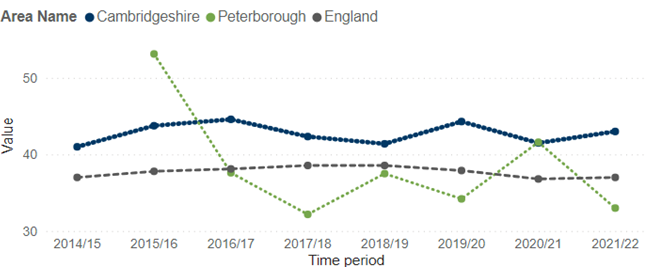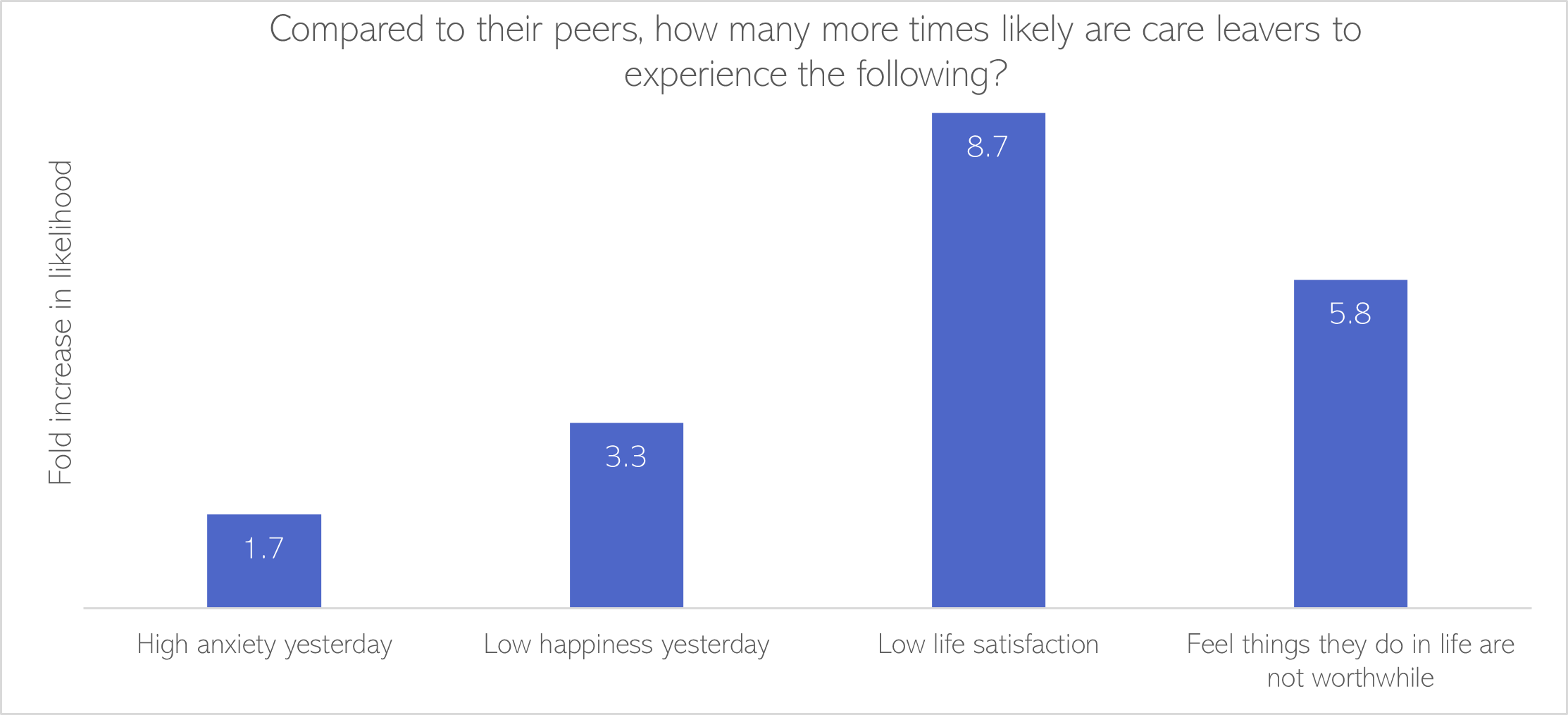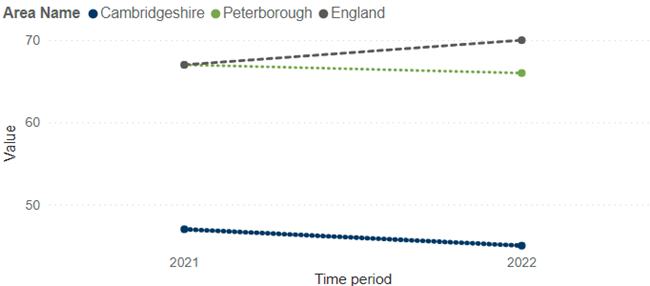Care experienced people
Note on terminology: ‘Care experienced’ refers to anyone who has been or is currently in care, or is from a looked-after background at any stage in their life (Scottish Government, 2021). Children and young people in care, or ‘Looked After’ children, have been in the care of the local authority for over 24 hours. They are generally either living with foster parents, living in a residential children’s homes or living in residential settings (such as a school or secure unit) (NSPCC, 2022). Care leavers are young people and adults who have spent time in the care system.
Nationally, 45% of children in care, and 72% of children in residential care, have a diagnosable mental health condition (Lewis & Lenehan, 2012). This is substantially higher than the prevalence in the general population (10%). Higher rates of mental health conditions in children in care persist even after adjusting for higher levels of poverty and disadvantage (Priestley et al., 2015).
43% of ‘Looked After’ children in Cambridgeshire, and 36% in Peterborough, had poor emotional wellbeing in 2020/21. This was a similar proportion to the national average (37%).
Figure 71: Proportion of ‘Looked After’ children (aged 5 to 16) whose emotional wellbeing was a cause for concern, 2014/15 – 2021/22. Data source: Fingertips Note: ‘Looked After’ children defined here as those who have spent at least 12 months in care; and poor emotional wellbeing as having a strength and difficulties (SDQ) score of at least 17.
A high proportion of children in care have multiple mental health conditions, some of which may go undiagnosed (Priestley et al., 2015). There are also high rates of self-harm amongst children in care (Priestley et al., 2015). One large review of case files of care leavers found that (N. Smith, 2017):
- 46% had been identified with mental health needs.
- 1 in 4 had faced a mental health crisis since leaving care.
- Diagnoses of PTSD were common and were often specifically linked to the reason why young people came into care.
A high proportion care leavers have poor levels of emotional wellbeing, including being over 8 times more likely to have low life satisfaction compared to their peers in the general population (Briheim-Crookall et al., 2020).
Figure 72: Compared to their peers in the general population, how many more times likely are care leavers (aged 16 to 24) to report the following aspects of poor wellbeing? Data source: (Briheim-Crookall et al., 2020)
The time at which young people leave care, often at age 18, is a vulnerable point for mental health. Children in care and care leavers are 4 to 5 times more likely to attempt suicide than their peers (Lewis & Lenehan, 2012), with evidence suggesting that care leavers of all ages are over-represented in suicide statistics (Priestley et al., 2015). One study which interviewed young people within 3 months after they had left care, and a year later, found that they had become (Priestley et al., 2015):
- 2 times more likely to report mental health problems (an increase from 12% to 24%).
- 8 times more likely to report problems with drugs or alcohol (increase from 18% to 32%).
- 6 times more likely to report ‘other health problems’ such as asthma and illnesses related to drug or alcohol use (28% to 44%).
Finally, a survey carried out by Adoption UK found 43% of adopted children have recognised social, emotional and mental health needs; and that 46% had accessed mental health services during 2020 (Adoption UK, 2021).
Local population
In 2022, there were 597 children in care (45 per 10,000 children under 18) in Cambridgeshire and 354 children in care (66 per 10,000 children under 18) in Peterborough (LG Inform, 2022). The rate of children in care in Cambridgeshire is lower than the national average; whilst the rate of children in care in Peterborough is similar to the national average.
Figure 73: Children (under 18s) in care (rate per 10,000 population aged under 18 years), 2021 – 22. Data source: Fingertips
Risk factors for poor mental health
There are a range of factors that can impact the mental health of children in care, ranging from wider structural factors such as stigma, to child-level factors (Priestley et al., 2015).
- The situations leading to children being placed in care can have a significant impact on their emotional wellbeing (National Institute of Health Research, 2021).
- 2 in 3 children in care have at least one physical health problem (Lewis & Lenehan, 2012).
- Children in care are more likely to come in contact with the criminal justice system: more than half(52%) of children in care have a criminal conviction by the age of 24, compared to 13% of young people who have not been in care (Stafford et al., 2022).
- Children in care are more likely to experience sexual exploitation (Priestley et al., 2015).
- Around 7% of children in care are unaccompanied asylum seekers (Department for Education, 2022a), who are likely to experience specific risk factors for poor mental health.
- Children in care experience educational inequalities. For example, the average attainment 8 score of children in care in Cambridgeshire is lower than the national average in 2020; whilst it was higher than average in Peterborough in 2019 and 2020.
Figure 74: Average Attainment 8 score of children in care. Data source: Fingertips. Note: Attainment 8 scores are calculated by adding together pupils’ highest GCSE scores (measured from 1 to 9, where 9 is the highest grade), across 8 government approved school subjects. The y axis does not start at 0 on this graph.
Care leavers are more likely than the general population to face a range of risk factors for poor mental health, including financial insecurity, loneliness and poor quality housing (Briheim-Crookall et al., 2020).
Figure 75: Care leavers (16- to 24-year-olds) face poor environmental determinants of health population. Data source: (Briheim-Crookall et al., 2020)
- Young women who become pregnant within 18 – 24 months of leaving care may experience poor mental health linked to earlier trauma and a lack of emotional and social support (Connolly et al., 2012).
- Care leavers are at a much higher risk of not being in employment, education or training (NEET) than their peers: in 2021, 41% of care leavers in England aged between 19 and 21 were NEET, compared to around 9% of the general population (Association for Young People’s Health, 2022).
- Care leavers are more likely to experience homelessness, with one survey finding that 25% of people experiencing homelessness (often in ‘hidden’ forms such as sofa surfing) had been in local authority care (Reeve, 2011).
Access
Barriers to accessing mental health support include:
Structural barriers
- The mental health needs of children in care are often not assessed within the recommended time frame, and quality of assessments varies significantly across fostering agencies (N. Smith, 2017).
- Children in care who are moved around multiple placements are at higher risk of having a mental health condition but less likely to access healthcare (Priestley et al., 2015). 1 in 10 children in care experienced 3 or more different placements in 2022 (Department for Education, 2022a).
- 17% of care leavers aged between 16 and 24 do not have internet access at home, compared to 7% of their peers in the general population (Briheim-Crookall et al., 2020). This can lead to digital exclusion and prevent access to healthcare (Roesch-Marsh et al., 2021).
- Information about the mental health needs of young people leaving care is not always passed on to leaving care teams (N. Smith, 2017).
Healthcare system barriers
- The cut off for most CAMHS services at age 18 can create a ‘cliff edge’ of support at a time when young people leave care and are most vulnerable to poor mental health (N. Smith, 2017).
- Professionals working with care leavers may lack training and expertise in mental health (N. Smith, 2017).
Experience
Additional work is required to build the local picture of the inequalities in mental health services that may be faced by children in care and care leavers, in terms of experience and outcomes.
Outcomes
Additional work is required to build the local picture of the inequalities in mental health services that may be faced by children in care and care leavers, in terms of experience and outcomes.
Additional resources
- The local data pack gives an overview of key data and trends
- The health of looked after children and young people: a summary of the literature
- Coram Voice’s report What makes life good? Care leavers’ views on their well-being
- Barnardo’s report Neglected Minds: A report on mental health support for young people leaving care
- County Council offers greater protection for care leavers, and calls for a change in the law
- What does the evidence tell us about the type of support that would have the most impact on ensuring our care leavers can make a successful transition from being a supported young person into an independent adult, including the transition from education to work?
- Understanding health inequalities for young people who are care experienced
References
Full list of references is included at the end of this chapter.





